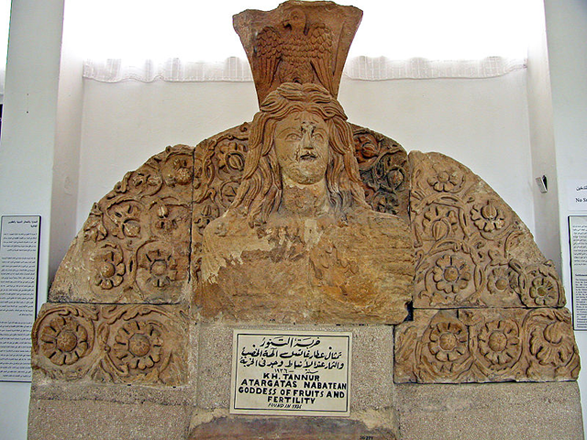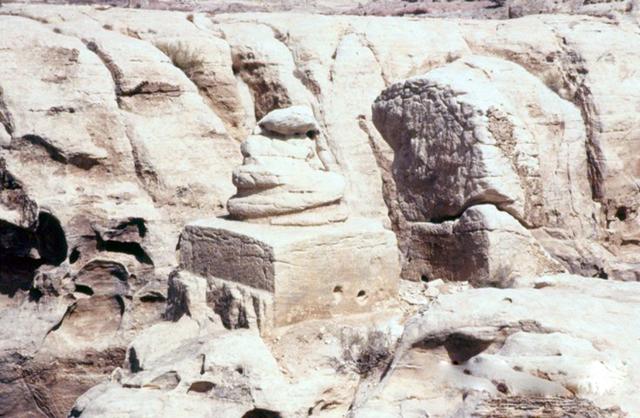You are here
Where astrology meets mythology: Discovering ancient sanctuary of Khirbat at-Tannoris
By Saeb Rawashdeh - Mar 21,2024 - Last updated at Mar 21,2024

Nabataean depiction of Atargatis from Khirbet at-Tannor that was placed on the inner temenos enclosure entrance (Photo courtesy of Jordan Archaeological Museum)
AMMAN — Khirbat at-Tannoris, located at the northern border of Edom, near Wadi Al Hasa, was excavated by the American archaeologist Nelson Glueck in 1937. Few decades later, Glueck published a book “Deities and Dolphins” in 1965 highlighting the artistic side of the sanctuary as well as the Nabataean belief system. Sculptures at Khirbat at-Tannoris were evaluated by different scholars and one of them has been a German historian Robert Wenning who studied the Nabataean astral belief.
Khirbat at-Tannoris and the nearby Khirbat adh- Dharih were found by the Nabataeans, but the monumental extension of the sanctuaries at both sites took place in the first half of the 2nd century AD (that is the early phase of the new Provincia Arabia after Roman Empire annexed Petra in 106 AD).
“The subject of the frieze of the Qasr adh- Dharih, excavated by François Villeneuve and Zeidun Muheisen, was recognised in 1999 by the bust of Libra with a balance as busts of the zodiac figures in alternation with standing Nike figure,” Wenning said, adding that the busts of Taurus, the Gemini, Cancer, Libra and a fragment of Sagittarius and some Nike figures are also preserved.
The identification of the busts is facilitated by their crowning attributes, such as the horns on the bust of Taurus, the professor said, noting that another researcher, Judith McKenzie, elaborated on the zodiac approach and gave a new interpretation of the so-called Dolphin Goddess from Khirbat at-Tannoris.
“Previously, Glueck understood that this bust was a representation of the Syrian goddess Atargatis and that this relief was the corner-stone of his interpretation of the entire decorative programme of Khirbat at-Tannoris,” Wenning said, adding that McKenzie correctly demonstrated that the marine creatures in the hair of the bust are clearly fish, and not dolphins, identical to the fishes in the zodiac.
The counterpart of the bust with the fish is a female bust with ears of grain in the hair, so-called Grain Goddess, how Glueck described her.
“McKenzie identified the two busts as zodiac signs, Virgo and Pisces, already suggested by Starcky and the busts decorated the outer pilasters of platform III, which is about a century later than the main phase of the sanctuary,” Wenning elaborated, noting that there are five other panels with busts, but they follow a more simplistic pattern.
The zodiac roundel with a bust of a female deity in its middle is carried by a Nike and in comparison with other zodiacs (the arrangement of the signs at the at-Tannoris zodiac differs from the usual sequence).
“It starts at the top with the bust of Aries, runs down to Virgo in the left half, then turns back to the top to Libra and runs down to Pisces in the right half. To explain this peculiarity the two halves have been interpreted as the civil year beginning with the month Nisan [consists of 30 days] on the left, and the normal year beginning with Tishri [seventh month of ecclesiastical year] on the right,” Wenning explained, adding that this presumed blending and integration of two calendars and two different New Year was result of the Egyptian influence.
Due to political, economic and social influence of the Egyptian society, there are certain parallels for a divided zodiac, but, significantly, none for a divided zodiac ring nor for a change of sequence of zodiacs.
“Indeed, another interpretation seems to be possible. Not only is the sequence of the signs unusual, but also the iconography of various signs as busts,” Wenning said, adding that the zodiac is organised in pairs, the most prominent ones being the two on top.
Consequently, Aries and Libra indicate the spring and the autumn equinox, and East and West. In the Babylonian mythology, the ram is connected with the moon, the scales with the sun, and both moon and sun are male deities, Wenning underlined.
“That might explain why Aries is here pictured as a male bust, wrongly interpreted by Glueck as bust of Athena. At first glance it may seem far-fetched to bring in Babylonian models as an explanation, but one must consider that Hellenistic-Roman world was thoroughly acquainted with Babylonian astronomy.
Convincingly, the two masks in the frieze of the Tomb with the Armour at Petra and the masks of some tombs at Hegra are interpreted as a representation of the beheaded Sumerian-Babylonian demon Humbaba, Wenning said.
Related Articles
AMMAN — Within Nabatean polytheism, the importance of the Nabatean god Dushara increased with the political and economic development of the
AMMAN — The professor of Pantheon-Sorbonne, Francois Villeneuve, has worked for decades in the region and some of his project included the N
AMMAN — Petra’s Snake Monument in the southern part of the rose-red city offers clues to the role of serpents in Nabataeans religious practi














